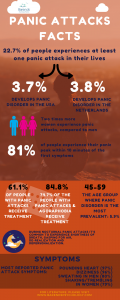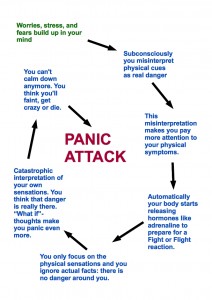Interesting panic attacks facts.
Due to the vast amount of mental health websites that write about mental disorders, such as panic disorder, you can find a lot of information about each mental disorder. However, it’s difficult to tell which information can be trusted and which not. This page, therefore, contains only interesting panic attacks facts from scientific journals. Be aware of the difference between a panic attack and a panic disorder, because these terms are used a lot on this page. A panic attack is a sudden surge of overwhelming fear and anxiety. If you experience a lot of panic attacks, or have severe anxiety without panic attacks, you may suffer from panic disorder. Please scroll down to start reading all about the interesting panic attacks facts.
For more information about panic attacks:
- What is a panic attack?
- Panic attack causes.
- Panic attack treatment.
- Take the panic attacks test.
- How to stop panic attacks?
- Online counseling for panic attacks.
- Take me to the homepage.
For those who do not know how to stop panic attacks themselves, we offer online counseling for panic attacks and panic disorders. Contact us straight away for a first, free of charge, appointment. (Depending on your health insurance, treatment may be reimbursed).
Interesting panic attacks facts – prevalence and comorbidity.
- 22.7% of people in the United States experience a panic attack once in their lives [1].
- Women are twice as likely to experience a panic attack, compared to men [10].
- In the United States, 0.8% experiences at least one panic attack with Agoraphobia in their lives [1].
- 71.9% of the people with only panic attacks suffer another mental disorder as well [1].
- 100% of the people with panic attacks and agoraphobia suffer another mental disorder as well [1].
- 81% of people with a panic attack report that their symptoms usually reach their peak within 10 minutes of the first symptom [4].
- 19% of people with a panic attack have their peak later than 10 minutes after the first symptom [4].
- 61.1% of the people with only panic attacks will receive treatment for psychiatric problems in their lives [1].
- 74.7% of the people with panic attacks and agoraphobia will receive treatment for psychiatric problems in their lives [1].
Interesting panic disorder facts – prevalence and comorbidity.
- Panic disorder is prevalent in 3.7-4.1% of people in the United States [1],[5],[9] and in approximately 2.0% in Europe [2].
- 1.1% of people in the US has panic disorder plus Agoraphobia at least once in their lives [1],[5].
- Women are approximately 2 times as likely to develop panic disorder compared to men [1],[3],[10]; 3.0% of women versus 1.7% of men [3].
- First onset for panic disorder is in adolescence and early adulthood [3],[10].
- On average a person suffers 2.2 years from panic disorder [1].
- 83.1% of the people with panic disorder (and no Agoraphobia) suffer another mental disorder as well [1].
- Of those people with panic disorder, 24.1% of women and 5% of men reported a history of being sexually molested [11]. This suggests that trauma may be a risk factor to the development of panic disorder.
- 100% of the people with panic disorder and Agoraphobia suffer another mental disorder as well [1].
- In Germany, 19.2% of the psychosomatic patients were also diagnosed with panic disorder [6].
- 4.4% of US Citizens between 18-29 years had a panic disorder; 5.7% in the age group 30-44, 5.9% in the age group 45-59, and 2% of the 60+ people [1].
- More than 90% of first-degree relatives or probands with panic disorders also had an affective disorder diagnosis [7], which suggests that panic disorder runs in the family. A proband is the first in the family line to develop a certain mental disorder.
- 84.8% of the people with panic disorder (and no agoraphobia) will receive treatment for psychiatric problems in their lives [1].
- 96.1% of the people with panic disorder and agoraphobia will receive treatment for psychiatric problems in their lives [1].
(Advertisement. For more interesting panic attacks facts, please scroll down.)
Interesting panic attacks facts – symptoms.
- The most reported panic disorder symptoms are Pounding Heart (97%) [4],[10], Dizziness (96%) [4], Sweating in men (80%) [10], Shaking/trembling in women (79%) [10].
- The least reported panic disorder symptom is Paresthesias (73%) in study [4] and nausea (35% in men, 45% in women) in study [10].
- People with panic disorder have a significantly lower heart rate variability, compared to healthy individuals, which suggests reduced flexibility and adaptability across biological, affective and behavioral dimensions [8],[13].
- Restless legs syndrome has been linked to panic disorder; 16.7% of the people with restless legs syndrome had panic disorder, compared to 4.1% of the normal population [9].
- The amount of panic attacks is highest in people who have Panic disorder with Agoraphobia, and lowest in people who only have a panic attack in their lives.
- Panic disorder and major depression is a common combination of disorders [12].
Interesting panic attacks facts – miscellaneous
- Nocturnal panic attacks: it is possible to have panic attacks while you are sound asleep. The symptoms are similar to those of daytime panic attacks. You may experience shortness of breath, gasping for air, and chest pain. Also, feelings of de-realization and depersonalization are common. You might feel like you are watching yourself from a distance.
- Caffeine consumption can make people with panic attacks perceive physical changes as if they are actual panic attack symptoms. This happens more automatic than conscious, so it is difficult to notice. For more information about the effect caffeine has on panic attacks, please visit: caffeine and mental disorders.
(Advertisement. For more interesting panic attacks facts, please scroll down.)
- Normal day and night rhythm is very important to reduce the amount of panic attacks. People who sleep too little or go to bed too late worry more. The more you worry, the bigger the chance you will start worrying about a next panic attack (and actually having one).
- Panic attacks can occur suddenly or expected. Suddenly: when people are triggered by external stimuli (phobic stimulus or traumatic stimulus) they can get a panic attack ‘without warning’. Expected: someone who associates ‘going to the supermarket’ with having a panic attack (because that person had 2 panic attacks in the supermarket) will most likely have a panic attack in the supermarket again. Not because the supermarket causes the panic attack, but because the person is misinterpreting his own physical cues.
Interesting Panic Attacks Facts – Literature
- [1] Kessler, R. C., Chiu, W. T., Jin, R., Ruscio, A. M., Shear. K., & Walters, E. E., 2006. The epidemiology of panic attacks, panic disorders, and agoraphobia in the National Comorbidity Survey Replication. Arch. Gen. Psychiaty, 63, 415-424.
- [2] Trimbos Instituut (paniekstoornis).
- [3] Goodwin, R. D., Farvelli, C., Rosi, S., Cosci, F., Truglia, E., de Graaf, E., Wittchen, H. U., 2005. The epidemiology of panic disorder and agoraphobia in Europe. Eur. Neuropsychopharmacol., 15, 435-43.
- [4] Craske, G. M., Kircanski, K., Phil, M. A. C., and others, 2010. Panic disorder: a review of DSM-IV panic disorder and proposals for DSM-V. Depression and anxiety, 0, 1-20.
- [5] Grant, B. F., Hasin, D. S., Stinson, F. S., Dawson, D. A., Goldstein, R. B., Smith, S., … & Saha, T. D. (2006). The epidemiology of DSM-IV panic disorder and agoraphobia in the United States: results from the National Epidemiologic Survey on Alcohol and Related Conditions. The Journal of clinical psychiatry.
- [6] Löwe, B., Gräfe, K., Zipfel, S., Spitzer, R. L., Herrmann-Lingen, C., Witte, S., & Herzog, W. (2003). Detecting panic disorder in medical and psychosomatic outpatients: comparative validation of the Hospital Anxiety and Depression Scale, the Patient Health Questionnaire, a screening question, and physicians’ diagnosis. Journal of psychosomatic research, 55, 515-519.
- [7] MacKinnon, D. F., Zandi, P. P., Cooper, J., Potash, J. B., Simpson, S. G., Gershon, E., … & DePaulo, J. R. (2002). Comorbid bipolar disorder and panic disorder in families with a high prevalence of bipolar disorder. American Journal of Psychiatry, 159, 30-35.
- [8] McCraty, R., Atkinson, M., Tomasino, D., & Stuppy, W. P. (2001). Analysis of twenty-four hour heart rate variability in patients with panic disorder. Biological psychology, 56, 131-150.
- [9] Lee, H. B., Hening, W. A., Allen, R. P., Kalaydjian, A. E., Earley, C. J., Eaton, W. W., & Lyketsos, C. G. (2008). Restless legs syndrome is associated with DSM-IV major depressive disorder and panic disorder in the community. The Journal of neuropsychiatry and clinical neurosciences, 20, 101-105.
- [10] Sheikh, J. I., Leskin, G. A., & Klein, D. F. (2002). Gender differences in panic disorder: findings from the National Comorbidity Survey. American Journal of Psychiatry, 159, 55-58.
- [11] Leskin, G. A., & Sheikh, J. I. (2002). Lifetime trauma history and panic disorder: findings from the National Comorbidity Survey. Journal of Anxiety Disorders, 16, 599-603.
- [12] Roy-Byrne, P. P., Stang, P., Wittchen, H. U., Ustun, B., Walters, E. E., & Kessler, R. C. (2000). Lifetime panic–depression comorbidity in the National Comorbidity Survey: Association with symptoms, impairment, course and help-seeking. The British Journal of Psychiatry, 176, 229-235.
- [13] Garakani, A., Martinez, J. M., Aaronson, C. J., Voustianiouk, A., Kaufmann, H., & Gorman, J. M. (2009). Effect of medication and psychotherapy on heart rate variability in panic disorder. Depression and Anxiety, 26, 251-258.


